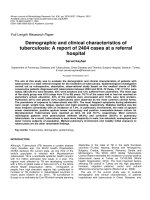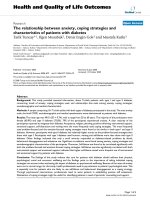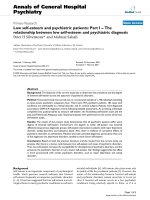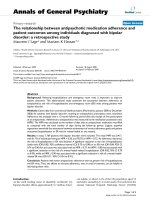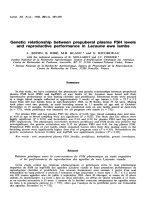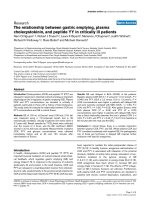Studying the relationship between plasma dopamine levels and clinical characteristics of bipolar disorder, manic episode
Bạn đang xem bản rút gọn của tài liệu. Xem và tải ngay bản đầy đủ của tài liệu tại đây (69.63 KB, 4 trang )
����������������������������������������������������������������������������������������������������������������������������������������������������������������������������������������������������������������������������������������������������������������������������������������������������������������������������������������������������������������������������������������������������������������������������������������������������������������������������������������������������������������������������������������������������������������������������������������������������������������������������������������������������������������������������������������������������������������������������������������������������������������������������������������������������������������������������������������������������������������������������������������������������������������������������������������������������������������������������������������������������������������������������������������������������������������������������������������������������������������������������������������������������������������������������������������������������������������������������������������������������������������������������������������������������������������������������������������������������������������������������������������������������������������������������������������������������������������������������������������������������������������������������������������������������������������������������������������������������������������������������������������������������������������������������������������������������������������������������������������������������������������������������������������������������������������������������������������������������������������������������������������������������������������������������������������������������������������������������������������������������������������������������������������������������������������������������������������������������������������������������������������������������������������������������������������������������������������������������������������������������������������������������������������������������������������������������������������������������������������������������������������������������������������������������������������������������������������������������������������������������������������������������������������������������������������������������������������������������������������������������������������������������������������������������������������������������������������������������������������������������������������������������������������������������������������������������������������������������������������������������������������������������������������������������������������������������������������������������������������������������������������������������������������������������������������������������������������������������������������������������������������������������������������������������������������������������������������������������������������������������������������������������������������������������������������������������������������������������������������������������������������������������������������������������������������������������������������������������������������������������������������������������������������������������������������������������������������������������������������������������������������������������������������������������������������������������������������������������������������������������������������������������������������������������������������������������������������������������������������������������������������������������������������������������������������������������������������������������������������������������������������������������������������������������������������������������������������������������������������������������������������������������������������������������������������������������������������������������������������������������������������7.38
n = 12
21.50 ± 6.09
p < 0.001
Unstalbe mood
n = 10
32.42 ± 6.76
n=1
19.13 ± 0.00
p > 0.05
Explosive mood
n = 21
35.30 ± 8.84
n=2
24.71 ± 2.65
p > 0.05
Tensive mood
n = 30
32.75 ± 7.32
n=3
21.60 ± 5.71
p < 0.05
(1: t1 - t2 = 9.8928 and p = 0.0000; 2: t1 - t2 = 13.29 and p = 0.094; 3.: t1 - t2 = 10.5855
and p = 0.113; 4: t1 - t2 = 11.1473 and p = 0.016)
168
Journal of military pharmaco-medicine n06-2018
Plasma dopamine levels in 2 surveys of increasing mood were statistically significant
differences with p < 0.001.
Plasma dopamine levels in 2 surveys of tensive mood had statistically significant
differences with p < 0.05.
Table 4: Relationship between plasma dopamine levels and activity.
Plasma dopamine levels (ng/L)
Statistical index
Test 1 time (t1)
Disorder of activity
Test 2 time (t2)
p1 = p2
n = 62
( X ± SD)
n = 62
( X = SD)
Hyperactivity
n = 57
31.08 ± 7.00
n=9
22.43 ± 6.42
p < 0.01
Interfering in everything
n = 34
31.90 ± 7.88
n=4
22.92 ± 6.32
p < 0.05
Do not cooperate on
medical examination
n =13
34.45 ± 7.24
n=1
31.87 ± 0.00
p > 0.05
Agitated activity
n = 31
33.88 ± 7.93
n=1
22.84 ± 0.00
p < 0.05
Waste of money
n = 12
32.26 ± 6.23
n=1
26.59 ± 0.00
p > 0.05
(1: t1 - t2 = 8.6597 and p = 0.001; 2: t1 - t2 = 8.9810 and p = 0.035; 3: t1 - t2 = 2.5769
and p = 0.738; 4: t1 - t2 = 11.0361 and p = 0.0181; 5: t1 - t2 = 5.6708 and p = 0.408)
Plasma dopamine levels in 2 surveys of hyperactivity were statistically significant
differenct with p < 0.01.
Plasma dopamine levels in 2 surveys of interfering in everything and hysterical
activity were statistically significant differences (p < 0.05).
Table 5: Relationship between plasma dopamine levels and delusions.
Plasma dopamine levels (ng/L)
Statistical index
Test 1 time (t1)
Kind of delusion
Test 2 time (t2)
p1 = p2
n = 62
( X ± SD)
n = 62
( X = SD)
Delusion of persecution
n = 19
37.41 ± 7.12
n=0
0
0
Grandiose delusions
n = 42
33.95 ± 7.01
n=4
14.60 ± 1.10
p < 0.001
Delusion of jealousy
n=4
35.39 ± 8.20
n=0
0
0
(1: t1 - t2 = 0 and p = 0; 2: t1 - t2 = 19.3457 and p = 0.0000; 3: t1 - t2 = 0 and p = 0)
Plasma dopamine levels in 2 surveys of grandiose delusions were statistically significant
differences with p < 0.001).
DISCUSSION
The first time test: n = 62; X = 34.40 ng/L;
SD = 7.38 ng/L; SE = 0.94; CI = 29.52 33.27. The second time test: n = 62;
X = 17.66 ng/L; SD = 5.95 ng/L; SE = 0.75;
CI = 16.15 - 19.18. The two surveys of test
dopamine were statistically significant
difference with p < 0.001.
Ambade V et al (2011) found that
mean ± standard deviation of plasma
dopamine in healthy was 21.8 ± 9.5 ng/L.
169
Journal of military pharmaco-medicine n06-2018
Cousins D.A et al (2009) found that
dopamine plays a very important role in
the pathogenesis of bipolar mood disorders,
mania. The authors suggested that dopamine
levels increase and dopaminergic activity
increase in the brain.
- Plasma dopamine levels in 2 surveys
of F31.1 and F31.2 were statistically
significant different with p < 0.001.
Sadock B.J (2015) supposes that
symptoms of manic episodes without
psychosis and psychosis are similar.
- Plasma dopamine levels statistically
significantly decreased in patients with
increasing mood, emotional tension,
hyperactivity, agitated activity and grandiose
delusions.
According to Kristina R (2012), dopamine
is a catecholamine that plays a significant
role in bipolar disorders. Excess dopamine
activity facilitates mania and delusional
symptoms.
John Cookson (2013) found that drugs
with more specific dopamine-receptor
blocking actions have antimanic properties
although these drugs are less sedative,
without blocking actions at histamine or
noradrenaline receptors. He supposes
drug treatment (with olanzapine, quetiapine
and presumably the other antipsychotics)
improved the whole range of symptoms
(including elation, flight of ideas, grandiosity,
sexual interest, irritability, aggression,
general appearance and insight, as well
as the items most sensitive to sedation:
insomnia, overactivity and pressure of
speech).
170
CONCLUSION
After a period of treatment:
- Mean plasma dopamine levels in
patients decreased significantly p < 0.001
(from 31.40 ± 7.38ng/L in the first time to
17.66 ± 5.95ng/L in the second time).
- Plasma dopamine levels were statistically
significantly decreased in patients with
diagnostic groups F31.1 and F31.2.
- Plasma dopamine levels were
statistically significantly decreased in
patients with increasing mood, emotional
tension, hyperactivity, agitated activity
and grandiose delusions.
REFERENCES
1. Ambade V, Brig M.M A, Col P S et al.
Adrenaline, noradrenaline and dopamine level
estimation in depression: Does it help?.
MJAFI. 2009, 65, pp.216-220.
2. Cousins D.A, Butts K, Young A.H. The
role of dopamine in bipolar disorder. Bipolar
Disord: 11, pp.787-806. The Authors. Journal
Compilation. John Wiley & Sons A ⁄S.
3. John C. Dopamine hypothesis of Mania.
Journal of Mood Disorders. 3 (Suppl. 1),
S1-S3. 2013.
4. Kristina R.S, Bertalan D. Bipolar disorder:
Diagnosis, neuroanatomical and biochemical
background. Clinical research and treatment
approaches to affective disorders. Edited by
Dr. Mario Juruena. Published in print edition.
2012, February.
5. Sadock B.J, Sadock V.A. Mood disorders.
Synopsis of Psychyatry. Eleventh edition.
2015, pp.457-486.

